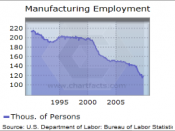In recent years, the structure of employment has altered enormously. One of the largest factors of this change is the growth of part-time employment.
The definition of part-time depends a great deal to its use. The office of national statistics defines the part-time "an employee expected to work no more than 30 hours , excluding all over time and main meal breaks , in a normal week; but exceptionally, an employee without specified normal basic hours, who is described as part-time by employer." The lab our force survey, uses a self-definition method, which gives a similar result of around 30 hours per week. (IRS employment trends 725)
Most businesses like the ones surveyed in IRS employment trends define part-time employment as those who work less than standard full-time hours for there occupation.
This however leaves discrepancies, for example, people working two part-time jobs, counted as two part-time workers by there employers, but themselves classified as a single full-time.
Since the Second World War, there have been enormous changes regarding employment, within Britain.
Up until the 1970's the most predominant type of employment was the standard type. This being a full-time, permanent, and often in the manufacturing sector of industry.
However in the last 30 years or so, enormous changes have happened to the structure of employment. The most important of these alterations, is the huge increase of females into the workforce. Within this time Britain's manufacturing industry has decreased rapidly. And the service industry has taken its place as the largest sector of employment. These have had an enormous effect on the growth of part-time employment. As women joining the work force often had other commitments, such as family responsibilities, they often were unable to work full time hours. Thus a large number of potential employees wanting to work...


